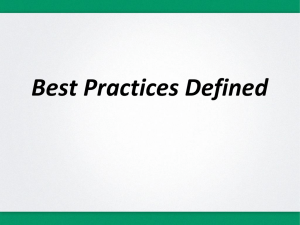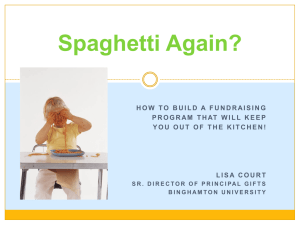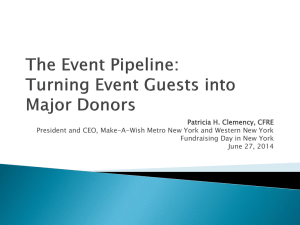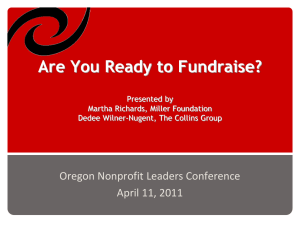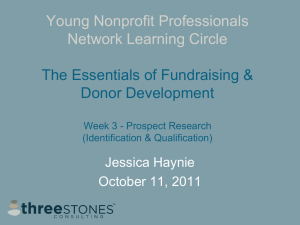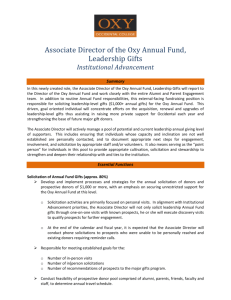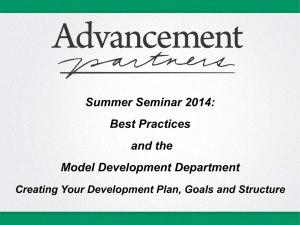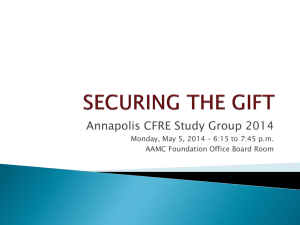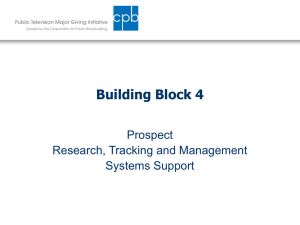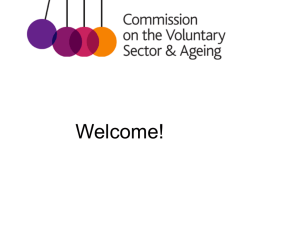Annual Giving
advertisement
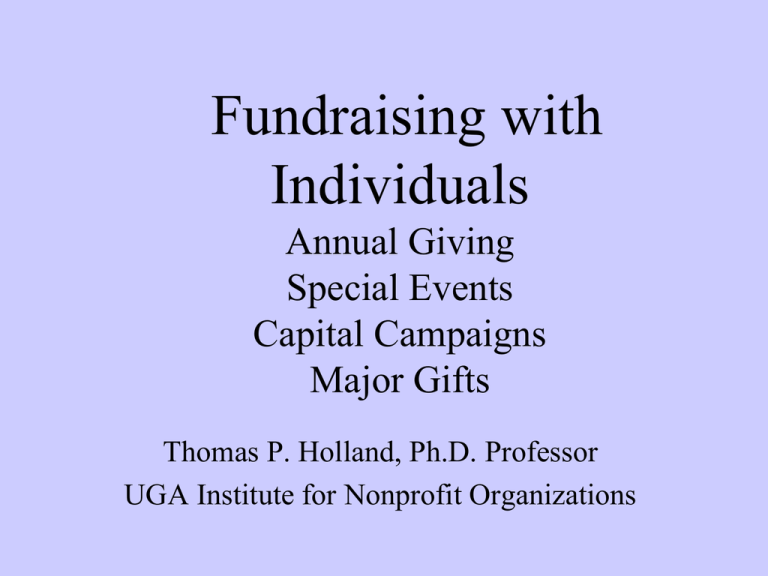
Fundraising with Individuals Annual Giving Special Events Capital Campaigns Major Gifts Thomas P. Holland, Ph.D. Professor UGA Institute for Nonprofit Organizations Annual Giving • Organized effort to secure gifts on an annual basis, either by mail, telephone, personal solicitation, events, or all four. • The primary fundraising method used to broaden support, upgrade giving levels, and provide operating support for ongoing programs. • The backbone of most fundraising programs. • Complements other forms of giving: planned, capital, endowment. • A cyclical, multi-stage process that may involve several solicitation strategies. Purpose of annual giving • • • • • • Acquire new donors Renew donor support annually Cultivate donors to increase giving levels Build donor loyalty Identify and involve leaders Identify major, capital gift prospects The Gift Pyramid • Rule of thirds: 1/3 of goal will come from top few gifts; the second 1/3 from larger number of midrange gifts; bottom third from larger number of smaller gifts • Must cultivate smaller donors to make giving a practice and to enlarge gifts in subsequent years • Must know donor capacity and approaches that will produce larger gifts (donor research) • Begin campaign with top prospects (quiet phase) Annual Giving in the Pyramid of Giving • New donors are unlikely to make significant gifts to an organization that is unfamiliar to them. • Annual giving programs build on initial gifts or expressions of donor interest to develop a consistent giving pattern. They represent an essential stage in the giving cycle before a major donor commitment is possible. • Time (3-5 years), energy, work and budget are required to build a broad base of predictable annual donors. Ladder of effectiveness Henry Rosso, Achieving Excellence in Fundraising, Jossey-Bass • • • • • • • • • • • Person to person solicitation Personal letter with phone follow up Personal phone call with follow-up letter Personal letter with no follow up Personal phone call with no follow up Fundraising benefit (event) Impersonal letter, direct mail Door-to-door Product sales Impersonal phone call (telemarketing) Media advertising Most Least Rules of thumb in annual giving 1. Understand what will motivate your donors or prospective donors before you plan your solicitation strategies. 2. Carefully match prospects to projects and to solicitation strategies. 3. Renew the same way you solicited the original gift. 4. Provide varied giving opportunities during the annual fund cycle. 5. Provide varied and multiple forms of appreciation during the annual fund cycle. 6. Track your results carefully to understand your donors’ giving patterns. Telephone solicitation, Phonathons • Works best for renewals or prospects who do not respond to mail • Most effective when combined with a before and after mail campaign • Good way to acquire information on donor base • Good way to involve natural volunteer groups (e.g., parents, alumni, students, former clients) • Good way to involve new volunteers in fundraising • Requires careful planning, training of callers Telephone solicitation set-up • • • • • • • Write a calling script, test it Obtain donor names, addresses, phone numbers Be prepared for mail follow-up to pledges Find a calling site and enough phones Organize volunteers, board and staff Train them Provide a fun and supportive atmosphere for callers • Hold post-mortem to evaluate results Mail Solicitation • Reaches the largest number, but least personal • Effective for renewing current donors, but be prepared to mail more than once • For new prospects, this is the least efficient both in terms of initial gift (1-2% return) and likelihood of renewal. • Requires significant investment of time to start a mail campaign: acquire prospects, develop package, buy postage, plan donor follow-up • Lots of good technical expertise available. • Test your letters, get evaluative feedback, revise. Special events • Pros: will raise visibility for your cause, and involve a certain kind of donor motivated by events. Good way to cultivate new prospects. Good way to socialize your board, volunteers, staff. Can be memorable event and lots of fun! • Cons: Requires huge amounts of time, people, energy. Rate of return may disappoint. Not the best option if you’re only in it for the $$. Special events set-up • Carefully plan budget; analyze goals, profitability. • Find a “niche” – an unusual or unique event – know your “competition”. • Understand your donor base – will they come? • Watch for conflicting events. • Involve experienced volunteers, event planners. • Have contingency plans for everything. • Understand the difficulties in renewing special event gifts. • Understand the tax consequences for donors. Personal Solicitation • Most effective and efficient form of fundraising • Requires training, planning and follow-up • Best way to involve board, other committed volunteers and donors • Requires understanding of volunteer recruitment, management and support needs, including prospect research Personal Solicitation • Preparation: – obtain accurate information about donor/prospect interests, past giving history, capacity. – Determine best person to contact the prospective donor (let volunteers pick their donor prospects) – Offer adequate support, training to solicitor • Presentation: – – – – Match solicitor to prospect Arrange to visit a prospect in person when possible Ask for a specific amount Follow through on any follow-up prospect requests Personal Solicitation (cont.) • The Close – Be positive, not apologetic if prospect declines – Be prepared to negotiate terms of gift – Make careful notes about next steps and follow through with donor – Thank them Example: Small college annual giving plan Targeted group Solicitation strategy Goal Board $250,000 Alumni In person Mail -- prospects < $500 Phonathon -- non mail donors In person -- prospects > $500 Area businesses In person Fall art auction Parents Same as alumni Students $250,000 $100,000 $500,000 $150,000 $100,000 $200,000 Spring special event $50,000 TOTAL $1,600,000 The Basics of Major Gifts • • • • Build on annual gifts but seek larger amounts Small number of givers will provide most funds The most cost-effective approach to fundraising May be used for – – – – New or expanded programs Capital for buildings or equipment Endowments Sponsorship of special need or activity Usually come from person’s assets (savings) rather than their current income • Go to organization’s assets rather than its current operations • Require extensive personal cultivation • Steps • 1. Specify major opportunities for sponsors, drawing from strategic plan and linking with prospect’s interest • 2. Plan the gift pyramid • 3. Identify likely givers – Records of prior giving – – – – Prior engagement with organization Interests and motivations Capacity to give Network of associates More steps • 4. Start with board members and others already engaged with organization • 5. Each person must make own gift first, before asking anyone else • 6. Timing: Consider special events in prospects’ lives (birth, marriage, change in business) • 7. Prepare personalized presentation, drawing on case statement and linking opportunity with prospect’s interests Steps (continued) • 8. Presentation plan – – – – – Personalized case statement Financial records of organization Opportunity for which gift is sought Benefit to giver Specific request and options • 9. Peer makes appointment to present in person, in private Asking for the gift • 1. Build rapport, show interest in prospect’s issues and concerns • 2. State the case for support of opportunity • 3. Encourage further involvement • 4. Identify benefits of action • 5. Ask for the gift • 6. Be quiet • 7. Respond appropriately • 8. Follow up with thank you, regardless of outcome • 9. Update records • 10. Report to donor about use of gift
